The Influence of Fly Ash from Sewage Sludge on the Concrete Carbonation Course
Abstract
1. Introduction
- -
- Increasing the depth of carbon dioxide penetration—the Ca(OH)2 content is low in concrete with additives, which results in a higher difference in CO2 concentrations in pores and intensifies diffusion,
- -
- Inhibitory—associated with the sealing of the concrete structure by ash and additional products of the pozzolanic reaction.
2. Materials and Methods
3. Results
The Course of Carbonation Adopted as the Basis for Modelling
4. Discussion
5. Conclusions
Author Contributions
Funding
Data Availability Statement
Conflicts of Interest
References
- Masters, L.W.; Brandt, E. Systematic methodology for service life. Prediction of building materials and components. Mater. Struct. 1988, 22, 285–392. [Google Scholar] [CrossRef]
- Deja, J. (Ed.) Concrete Technologies and Test Methods; Association of Cement Producers: Kraków, Poland, 2020. [Google Scholar]
- Neville, A.M. Concrete Properties; Association of Cement Producers: Kraków, Poland, 2012. [Google Scholar]
- Woyciechowski, P. Model of Concrete Carbonation; Publishing House of the Warsaw University of Technology: Warszawa, Poland, 2013. [Google Scholar]
- Majumdar, A.J.; Stuck, M.S. Microstructure of glass fibre reinforced supersulphated cement. Cem. Concr. Res. 1981, 11, 781–788. [Google Scholar] [CrossRef]
- Bakhareva, T.; Sanjayana, J.G.; Cheng, Y. Resistance of alkali-activated slag concrete to carbonation. Cem. Concr. Res. 2001, 31, 1277–1283. [Google Scholar] [CrossRef]
- Lagerblad, B. Carbon Dioxide Uptake during Concrete Life Cycle—State-of-the-Art; Swedish Cement and Concrete Research Institute—CBI: Stockholm, Sweden, 2005. [Google Scholar]
- Bernal, S.A.; de Gutierrez, R.M.; Provis, J.L. Carbonation of alkali-activated GBFS/MK concretes. In Proceedings of the International Congress on Durability of Concrete, Trondheim, Norway, 18–21 June 2012. [Google Scholar]
- Boos, P.; Giergiczny, Z. Testing the frost resistance of concrete with different cement types-experience from laboratory and practice. Archit. Civ. Eng. Environ. 2010, 2, 41–52. [Google Scholar]
- Deja, J. Corrosion durability of binders with different content of granulated blast furnace slag. Cem.-Lime-Concr. 2007, 12, 280–283. [Google Scholar]
- Du, J.; Jin, Z.; Jiang, J. Experimental Study of Fly Ash Concrete Carbonization. Coal Ash China 2005, 17, 9–11. [Google Scholar]
- Jackiewicz-Rek, W.; Woyciechowski, P. Influence of ash content on the course of carbonation of aerated concretes. In Proceedings of the 6th Conference Material Issues in Civil Engineering, MATBUD, Kraków, Poland, 20 April 2011; pp. 175–184. [Google Scholar]
- Johannesson, B.; Utgenannt, P. Microstructural changes caused by carbonation of cement mortar. Cem. Concr. Res. 2001, 31, 925–931. [Google Scholar] [CrossRef]
- Thiery, M.; Dangla, P.; Villain, G.; Platret, G.; Massieu, E.; Druon, M.; Baroghel-Bouny, V. Modeling the atmospheric carbonation of cementitious materials. Bull. Lab. Ponts Chaussees 2004, 252–253, 153–188. [Google Scholar]
- Fiertak, M.; Małolepszy, J. Concrete as a composite material subject to the influence of environmental factors. In Proceedings of the Scientific and Technical Symposium: Durability of Concrete and Its Technological, Material and Environmental Conditions, Kraków, Poland, 20 April 2004. [Google Scholar]
- Czarnecki, L.; Woyciechowski, P. Methods of Assessing the Course of Concrete Carbonation—Materials of the 2nd Scientific and Technical Symposium Concrete Durability; Górażdż Cement SA: Kraków, Poland, 2008; pp. 97–119. [Google Scholar]
- Kurdowski, W. Chemistry of Cement and Concrete; Polski Cement, Wydawnictwo Naukowe PWN: Kraków, Poland, 2010. [Google Scholar]
- Ahmaruzzaman, M. A review on the utilization of fly ash. Prog. Energy Combust. Sci. 2010, 36, 1349–1359. [Google Scholar] [CrossRef]
- Łagosz, A.; Deja, J. Evaluation of the impact of curing conditions and w/c ratio on the stiffness of the carbonation process of cement mortars. Cem.-Lime-Concr. 2011, 4, 207–216. [Google Scholar]
- Piasta, J.; Rawicz, Z.; Piasta, W. Carbonation of concrete in a reinforced concrete slab. In Proceedings of the Conference Proceedings of Days of Concrete, Wisła, Poland, 9–11 October 2008; pp. 277–286. [Google Scholar]
- Hainer, S.; Proske, T.; Graubner, C.A. Carbonation of cement reduced concretes. In Darmstadt Concrete—Annual Journal on Concrete and Concrete Structures 24; Darmstadt Concrete: Darmstadt, Germany, 2009. [Google Scholar]
- Kuosa, H.; Ferreira, M.R.; Holt, E. Concrete durability based on coupled deterioration by frost, carbonation and chloride. In Proceedings of the International Congress on Durability of Concrete, ICDC, Trondheim, Norway, 18–21 June 2012. article PP2. [Google Scholar]
- Bouikni, A.; Swamy, R.N.; Bali, A. Durability properties of concrete containing 50% and 65% slag. Constr. Build. Mater. 2009, 23, 2836–2845. [Google Scholar] [CrossRef]
- Dong, B.; Qiu, Q.; Xiang, J.; Huang, C.; Sun, H.; Xing, F.; Liu, W. Electrochemical impedance interpretation of the carbonation behavior for fly ash–slag–cement materials. Constr. Build. Mater. 2015, 93, 933–942. [Google Scholar] [CrossRef]
- Gao, Y.; Cheng, L.; Gao, Z.; Guo, S. Effects of different mineral admixtures on carbonation resistance of lightweight aggregate concrete. Constr. Build. Mater. 2013, 43, 506–510. [Google Scholar] [CrossRef]
- Khunthongkeaw, J.; Tangtermsiriku, S.; Leelawat, T. A study on carbonation depth prediction for fly ash concrete. Constr. Build. Mater. 2006, 20, 744–753. [Google Scholar] [CrossRef]
- Özbay, E.; Erdemir, M.; Durmuş, H.I. Utilization and efficiency of ground granulated blast furnace slag on concrete properties—A review. Constr. Build. Mater. 2016, 105, 423–434. [Google Scholar] [CrossRef]
- Kim, H.K.; Lee, H.K. Coal bottom ash in field of civil engineering: A review of advanced applications and environmental considerations. KSCE J. Civ. Eng. 2015, 19, 1802–1818. [Google Scholar] [CrossRef]
- Gonen, T.; Yazicioglu, S.; Demirel, B. The influence of freezing-thawing cycles on the capillary water absorption and porosity of concrete with mineral admixture. KSCE J. Civ. Eng. 2015, 19, 667. [Google Scholar] [CrossRef]
- EN 206+A2:2021-08; Concrete—Requirements, Properties, Production and Compliance. EN 197-1:2012 Cement—Part 1: Composition, Requirements and Conformity Criteria for Common Cements. Polish Standardization Committee: Warszawa, Poland, 2012.
- EN 450-1:2012; Fly Ash for Concrete. Part 1: Definitions, Specifications and Compliance Criteria. Polish Standardization Committee: Warszawa, Poland, 2012.
- EN 450-2:2006; Fly Ash for Concrete. Part 2. Compliance Assessment. Polish Standardization Committee: Warszawa, Poland, 2006.
- Arioz, O. Effects of elevated temperatures on properties of concrete. Fire Saf. J. 2007, 42, 516–522. [Google Scholar] [CrossRef]
- Brandt, A.M. Cement based composites: Materials, mechanical properties and performance. Taylor Fr. Group 2009, 535. [Google Scholar] [CrossRef]
- Jóźwiak-Niedźwiedzka, D. Influence of blended cements on the concrete resistance to carbonation. In Proceedings of the Brittle Matrix Composites 10; Woodhead Publishing: Warsaw, Poland, 2012; pp. 125–134. [Google Scholar]
- Shi, H.-S.; Xu, B.-W.; Zhou, X.-C. Influence of mineral admixtures on compressive strength, gas permeability and carbonation of high performance concrete. Constr. Build. Mater. 2009, 23, 1980–1985. [Google Scholar] [CrossRef]
- Jiang, L.; Liu, Z.; Ye, Y. Durability of concrete incorporating large volumes of low-quality fly ash. Cem. Concr. Res. 2004, 34, 1467–1469. [Google Scholar] [CrossRef]
- Hossain, K.M.A.; Lachemi, M. Development of model for the prediction of carbonation in pozzolanic concrete. In Proceedings of the Third International Conference on Construction Materials: Performance, Innovations and Structural Implications, University of British Columbia, Vancouver, BC, Canada, 22–24 August 2005. [Google Scholar]
- Kurda, R.; de Brito, J.; Silvestre, J.D. Carbonation of concrete made with high amount of fly ash and recycled concrete aggregates for utilization of CO2. J. CO2 Util. 2019, 29, 12–19. [Google Scholar] [CrossRef]
- Ghorbani, S.; Sharifi, S.; Ghorbani, S.; Tam, V.W.Y.; De Brito, J.; Kurda, R. Effect of crushed concrete waste’s maximum size as partial replacement of natural coarse aggregate on the mechanical and durability properties of concrete. Resour. Conserv. Recycl. 2019, 149, 664–673. [Google Scholar] [CrossRef]
- Carević, V.; Ignjatović, I.; Dragaš, J. Model for practical carbonation depth prediction for high volume fly ash concrete and recycled aggregate concrete. Constr. Build. Mater. 2019, 213, 194–208. [Google Scholar] [CrossRef]
- Papadakis, V.G. Effect of supplementary cementing materials on concrete resistance against carbonation and chloride ingress. Cem. Concr. Res. 2000, 30, 291–299. [Google Scholar] [CrossRef]
- Bier, T.A. Influence of type of cement and curing on carbonation progress and pore structure of hydrated cement paste. In Proceedings of the Materials Research Society Symposium, Erlangen, Germany, 27–29 April 1987; pp. 123–134. [Google Scholar]
- Dąbrowski, M.; Glinicki, M.A.; Gibas, K.; Jóźwiak-Niedźwiedzka, D. Effects of calcareous fly ash in blended cements on chloride ions migration and strength of air entrained concrete. Constr. Build. Mater. 2016, 126, 1044–1053. [Google Scholar] [CrossRef]
- Bary, B.; Sellier, A. Coupled moisture-carbon dioxide-calcium transfer model for carbonation of concrete. Cem. Concr. Res. 2004, 34, 1859–1872. [Google Scholar] [CrossRef]
- Woliński, P.; Woyciechowski, P.P.; Jaworska, B.; Adamczewski, G.; Tokarski, D.; Grudniewski, T.; Chodyka, M.; Nitychoruk, A. The influence of the mineral additives on the carbonation of cement composites. MATEC Web Conf. 2018, 196, 04062. [Google Scholar] [CrossRef]
- Glinicki, M.A.; Ładyżyński, K. Activated fly ash from fluidized bed boilers—A new additive to concrete. In Proceedings of the 18th Conference—Concrete and Prefabrication, Popowo, Poland, 10–11 April 2002. [Google Scholar]
- Czarnecki, L.; Woyciechowski, P. Concrete carbonation as a limited process and its relevance to CO2 sequestration. ACI Mater. J. 2012, 109, 275–282. [Google Scholar]
- Papadakis, V.G.; Fardis, M.N.; Vayenas, C.G. Effect of composition, environmental factors and cement-lime mortar coating on concrete carbonation. Mater. Struct. 1992, 25, 293–304. [Google Scholar] [CrossRef]
- Parrott, L.J.; Killoch, D.C. Carbonation in 36 years old, in-situ concrete. Cem. Concr. Res. 1989, 19, 649–656. [Google Scholar] [CrossRef]
- Bakker, R.F.M. Initiation period. In Corrosion of Steel in Concrete: Report of the Technical Committee 60-CSC RILEM; Schiessl, P., Ed.; Chapman and Hall: London, UK, 1988; pp. 22–54. [Google Scholar]
- Hergenröder, M. Zur Statistichen Instandhaltungsplanung Für Bestehende Betonbauwerke bei Karbonatisierung des Betons und Möglicher der Bewerhung. Ph.D. Thesis, Technische Universität, München, Germany, 1992. [Google Scholar]
- Nilsson, L.O. Interaction between microclimate and concrete—A perquisite for deterioration. Constr. Build. Mater. 1997, 10, 301–308. [Google Scholar] [CrossRef]
- Czarnecki, L.; Woyciechowski, P. Modelling of concrete carbonation; is it a process unlimited in time and restricted in space? Bull. Pol. Acad. Sci. Tech. Sci. 2015, 63, 43–54. [Google Scholar] [CrossRef]
- Czarnecki, L.; Woyciechowski, P.; Adamczewski, G. Risk of concrete carbonation with mineral industrial by-products. KSCE J. Civ. Engieering 2018, 22, 755–764. [Google Scholar] [CrossRef]
- ASTM C618-03; Standard Specification for Coal Fly Ash and Raw or Calcined Natural Pozzolan Use in Concrete. U.S. Department of Energy Office of Scientific and Technical Information: Washington, DC, USA, 1998.
- Jamroży, Z. Concrete and Its Technologies; Scientific Publishing House PWN: Warsow, Poland, 2015. [Google Scholar]
- EN 12390-3:2011; Concrete Testing. Part 3: Compressive Strength of Specimens for Strength Tests. Polish Standardization Committee: Warszawa, Poland, 2011.
- EN 12390-12:2010; Testing Hardened Concrete—Part 12: Determination of the Potential Carbonation Resistance of Concrete: Accelerated Carbonation Method. Polish Standardization Committee: Warszawa, Poland, 2010.
- Pachowski, J. Fly Ashes and Their Application in Road Construction; Communication and Connectivity: Warsaw, Poland, 1976. [Google Scholar]
- ASTM C379-65T; Specification for Fly Ash for Use as a Pozzolanic Material with Lime. American Society for Testing and Material: Washington, DC, USA, 1965.
- Bastion, S. Structural Concretes with Fly Ash; Arkady: Warszawa, Ploand, 1980. [Google Scholar]
- Tkaczewska, E. Properties of cements containing various grain fractions of siliceous fly ashes. Roads Bridges 2008, 4, 47–80. [Google Scholar]
- Szarek, Ł.; Wojtowska, M. Properties of fly ash from thermal treatment of municipal sewage sludge in terms of EN 450-1. Arch. Environ. Prot. 2018, 44, 63–69. [Google Scholar] [CrossRef]
- Eglinton, M.S. Concrete and Its Chemical Behavior; Thomas Telford: London, UK, 1987. [Google Scholar]
- Garcés, P.; Carrión, M.P.; García-Alcocel, E.; Payá, J.; Monzó, J.; Borrachero, M.V. Mechanical and physical properties of cement blended with sewage sludge ash. Waste Manag. 2008, 28, 2495–2502. [Google Scholar] [CrossRef] [PubMed]
- Małolepszy, J.; Tkaczewska, E. Influence of fly ashes from coal and biomass co-combustion on hydration process and cement properties. In Proceedings of the Materials of the 4th Scientific and Technical Conference “Concrete Days—Tradition and Modernity”, Wisła, Poland, 9–11 October 2006; pp. 591–601. [Google Scholar]
- De Noirfontaine, M.N.; Tusseau-Nenez, S.; Signes-Frehel, M.; Gasecki, G.; Girod-Labianca, C. Efect of phosphorus on tricalcium silicate T1: From synthesis to structural characterization. J. Am. Ceram. Soc. 2009, 92, 2337–2344. [Google Scholar] [CrossRef]
- Tarko, B.; Gorazda, K.; Wzorek, Z.; Nowak, A.K.; Kowalski, Z.; Kulczycka, J.; Henclik, A. Recovery of phosphorus from industrial sewage sludge ashes. Chem. Ind. 2014, 93, 1041–1044. [Google Scholar]
- Rutkowska, G.; Fronczyk, J.; Wichowski, P. Research on the Possibility of Using Fly Ashes from Combustion of Municipal Sewage Sludge on Properties of Ordinary Concretes. Annu. Set Environ. Prot. 2018, 20, 1113–1128. [Google Scholar]
- Kosior-Kazberuk, M. New mineral additives for concrete. Constr. Environ. Eng. 2011, 29, 47–55. [Google Scholar]
- Rutkowska, G.; Fronczyk, J.; Filipczuk, S. Influence of fly ash properties from thermal conversion of sewage sludge on the parameters of ordinary concrete. Acta Sci. Pol. Archit. 2020, 19, 43–54. [Google Scholar] [CrossRef]
- Rutkowska, G.; Wichowski, P.; Franus, M.; Mendryk, M.; Fronczyk, J. Modification of Ordinary Concrete Using Fly Ash from Combustion of Municipal Sewage Sludge. Materials 2020, 13, 487. [Google Scholar] [CrossRef] [PubMed]
- Rutkowska, G.; Wichowski, P.; Fronczyk, J.; Franus, M.; Chalecki, M. Use of fly ashes from municipal sewage sludge combustion in production of ash concretes. Constr. Build. Mater. 2018, 188, 874–883. [Google Scholar] [CrossRef]
- Fontes, C.M.A.; Barbosa, M.C.; Filho, R.D.T.; Goncalves, J.P. Potentiality of sewage sludge ash as mineral additive in cement mortar and high performance concrete. In Proceedings of the Conference: Use of Recycled Materials in Buildings and Structures (RILEM Publications), Barcelona, Spain, 8–11 November 2004; pp. 797–806. [Google Scholar]
- Yen, C.L.; Tseng, D.H.; Lin, T.T. Characterization of eco-cement paste produced from waste sludges. Chemosphere 2011, 84, 220–226. [Google Scholar] [CrossRef] [PubMed]
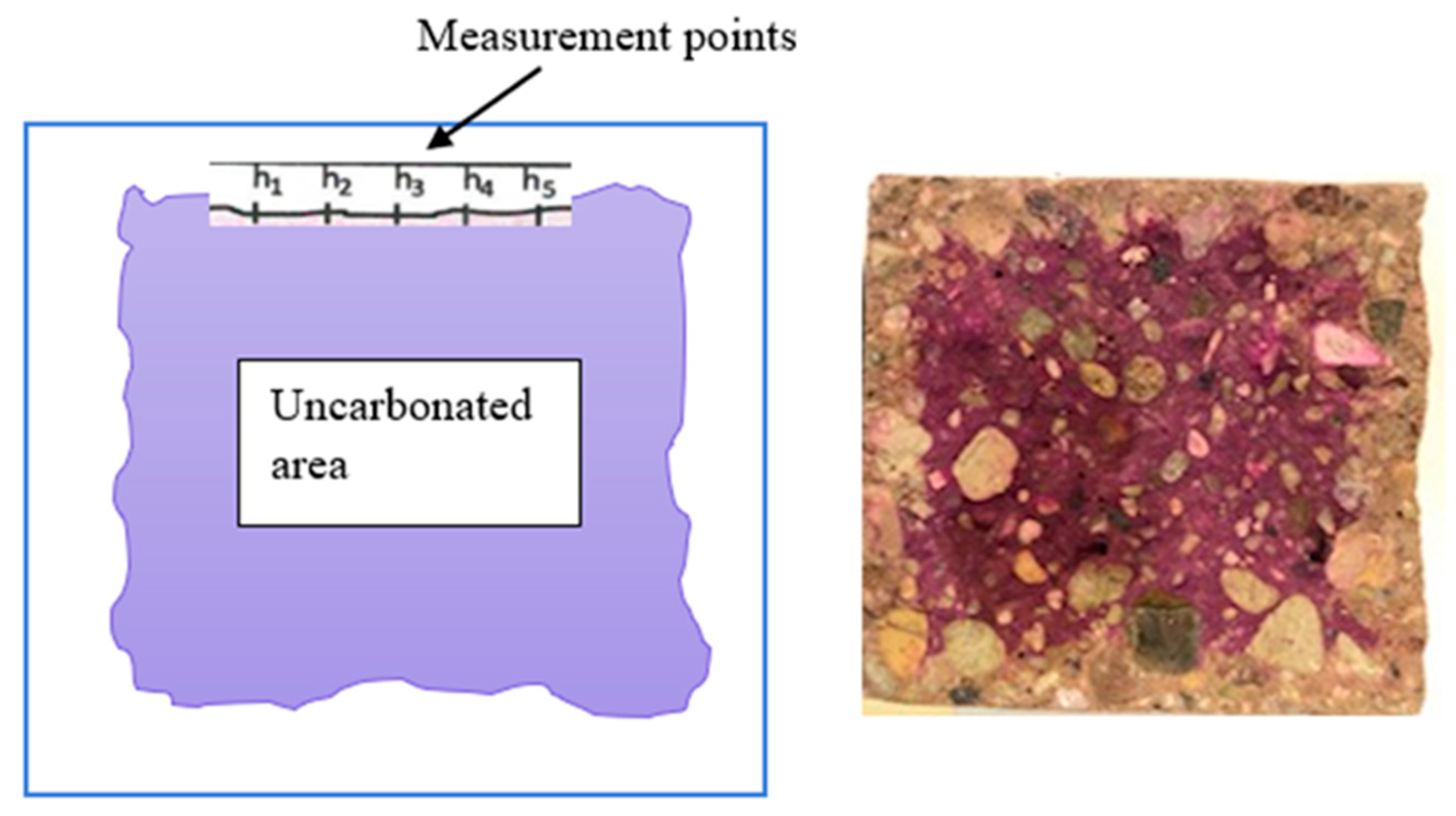

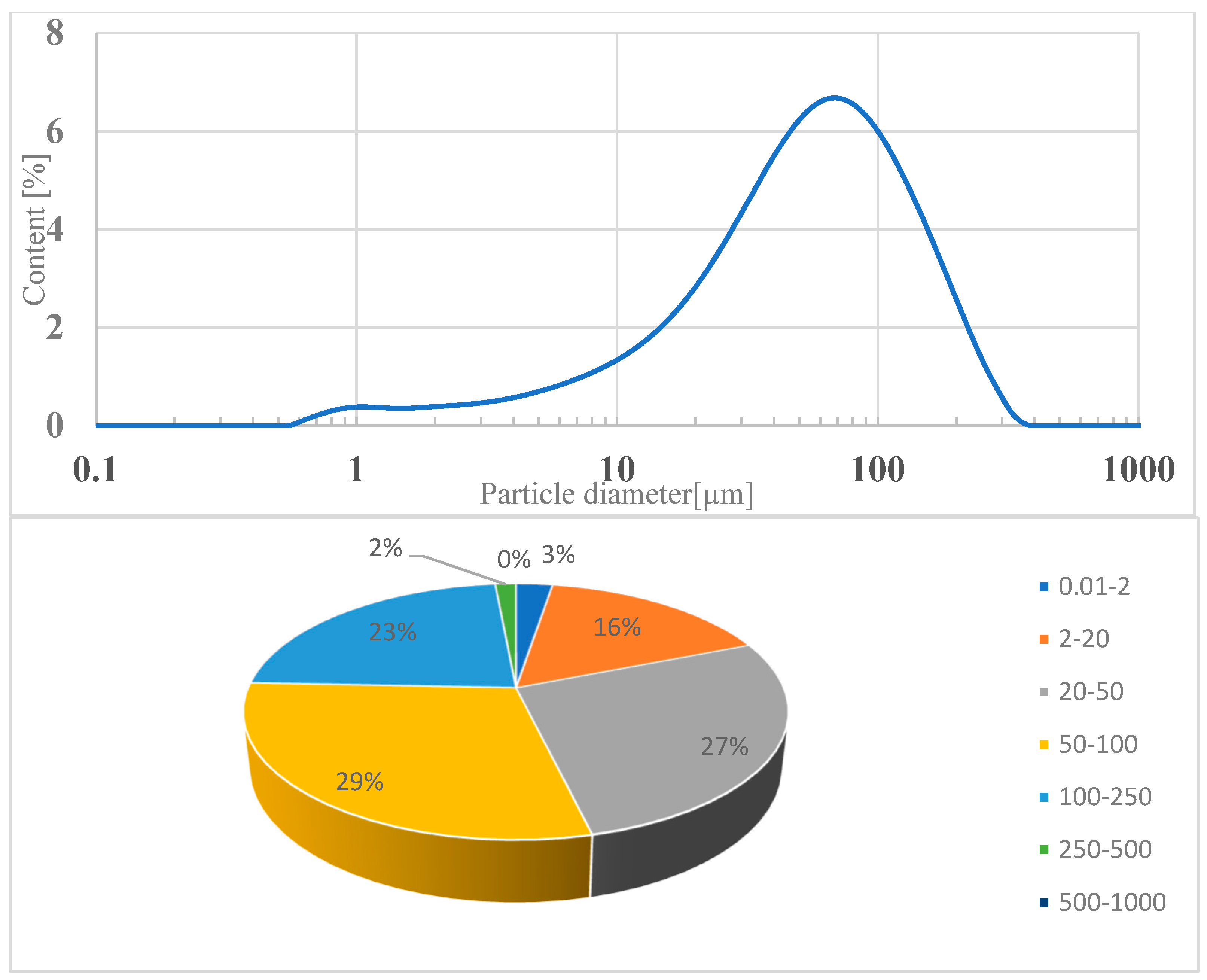
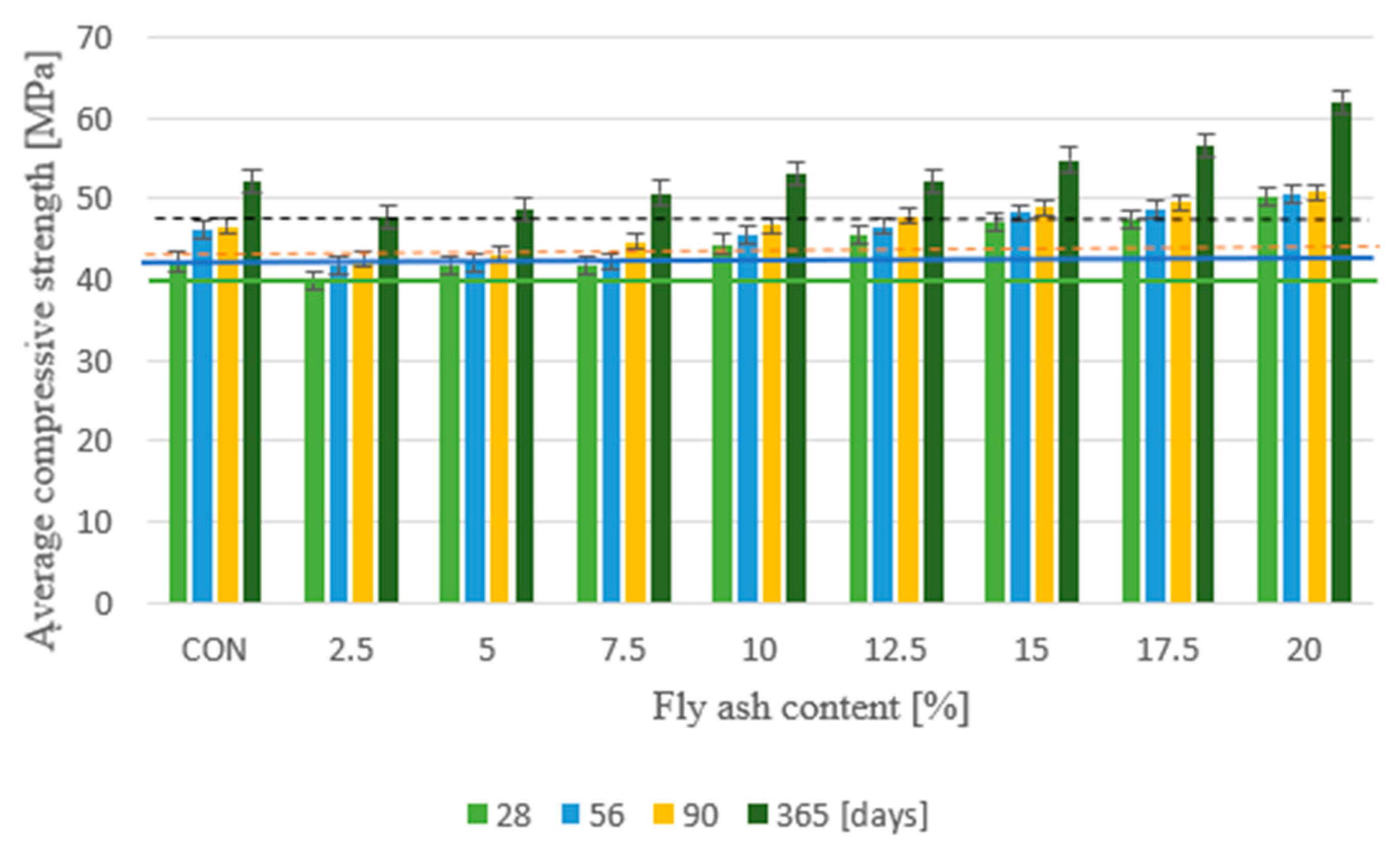
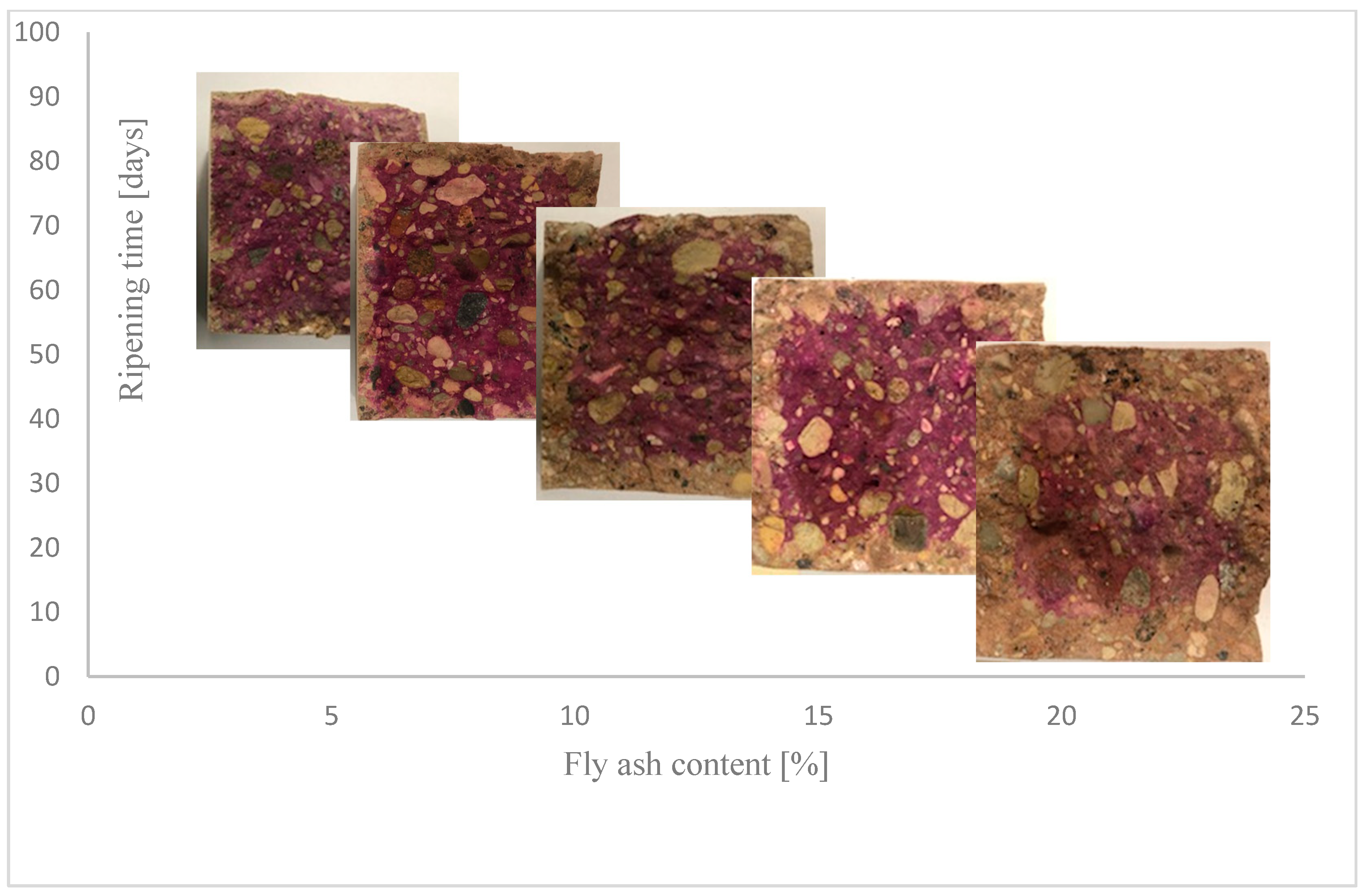
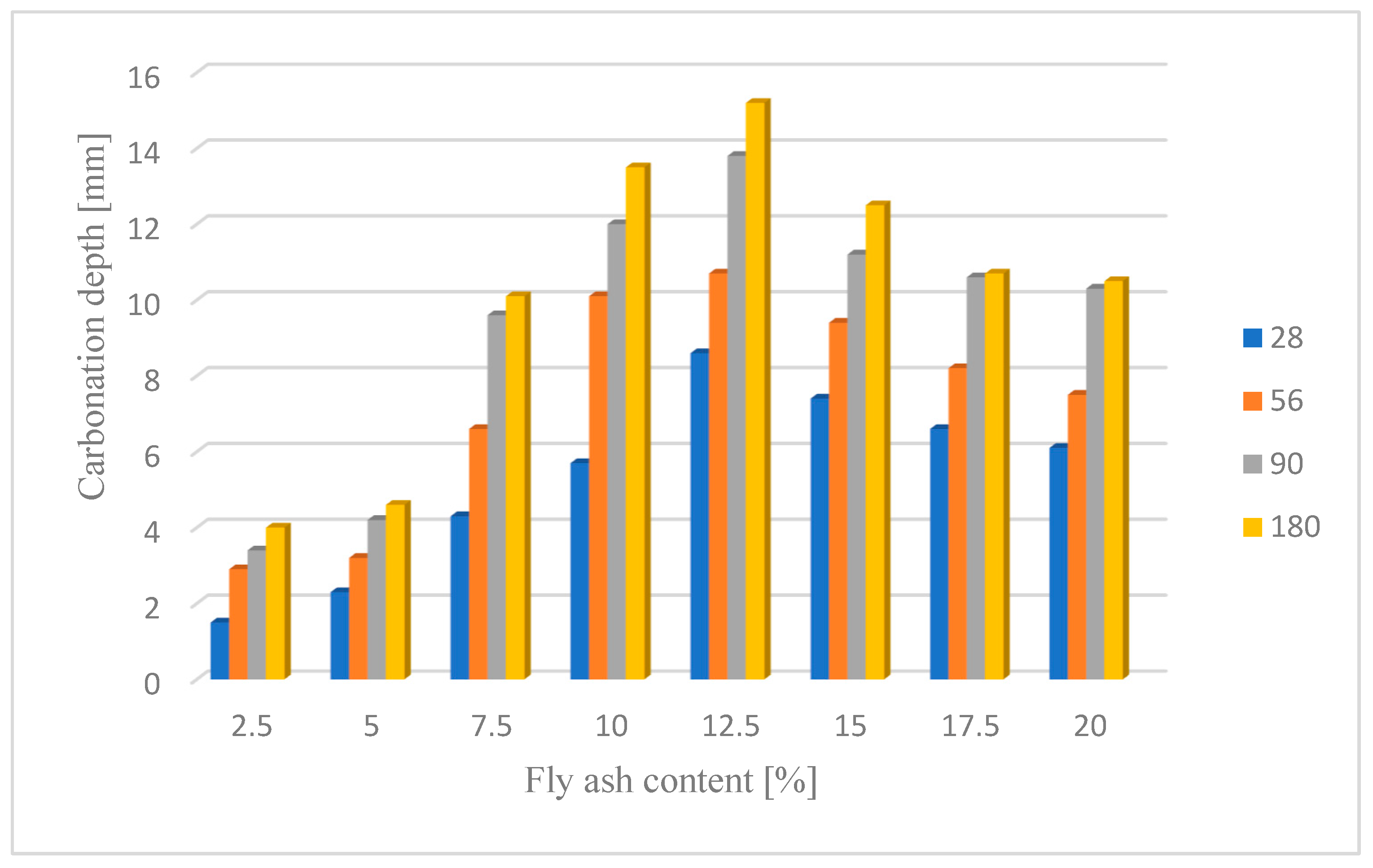
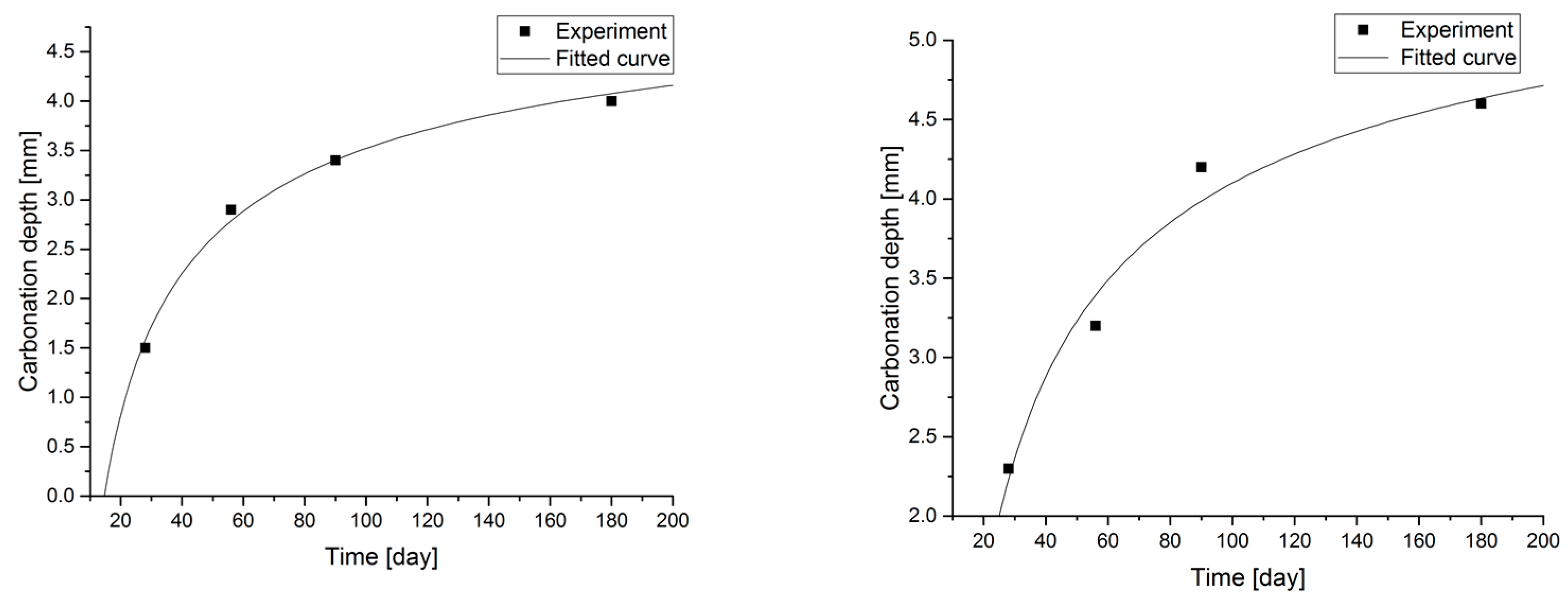



| Type of Sample | Cement | Water | Aggregate | Ash | w/c | p/c |
|---|---|---|---|---|---|---|
| BZ | 360.58 | 166.42 | 1900.74 | 0.46 | ||
| P2.5% | 351.57 | 9.01 | 0.47 | 0.026 | ||
| P5.0% | 342.55 | 18.03 | 0.48 | 0.053 | ||
| P7.5% | 333.54 | 27.04 | 0.50 | 0.081 | ||
| P10.0% | 324.52 | 36.06 | 0.51 | 0.111 | ||
| P12.5% | 315.51 | 45.07 | 0.53 | 0.143 | ||
| P15.0% | 306.49 | 54.09 | 0.54 | 0.176 | ||
| P17.5% | 297.48 | 63.10 | 0.56 | 0.212 | ||
| P20.0% | 288.46 | 72.12 | 0.58 | 0.250 |
| Type of Sample | Carbonation Model and Carbonation Rate | Asymptot [mm] | Correlation Coefficient R |
|---|---|---|---|
| P 2.5 | 3 | 5.7 | 0.99 |
| P 5.0 | 3 | 6.2 | 0.96 |
| P 7.5 | 3 | 14.5 | 0.92 |
| P 10.0 | 3 | 19.0 | 0.98 |
| P 12.5 | 3 | 19.6 | 0.93 |
| P 15.0 | 3 | 15.8 | 0.98 |
| P 17.5 | 3 | 13.9 | 0.88 |
| P 20.0 | 3 | 13.9 | 0.85 |
Disclaimer/Publisher’s Note: The statements, opinions and data contained in all publications are solely those of the individual author(s) and contributor(s) and not of MDPI and/or the editor(s). MDPI and/or the editor(s) disclaim responsibility for any injury to people or property resulting from any ideas, methods, instructions or products referred to in the content. |
© 2023 by the authors. Licensee MDPI, Basel, Switzerland. This article is an open access article distributed under the terms and conditions of the Creative Commons Attribution (CC BY) license (https://creativecommons.org/licenses/by/4.0/).
Share and Cite
Rutkowska, G.; Żółtowski, M.; Rusakov, K.; Pawluk, K.; Andrzejak, J.; Żółtowski, B. The Influence of Fly Ash from Sewage Sludge on the Concrete Carbonation Course. Buildings 2023, 13, 1838. https://doi.org/10.3390/buildings13071838
Rutkowska G, Żółtowski M, Rusakov K, Pawluk K, Andrzejak J, Żółtowski B. The Influence of Fly Ash from Sewage Sludge on the Concrete Carbonation Course. Buildings. 2023; 13(7):1838. https://doi.org/10.3390/buildings13071838
Chicago/Turabian StyleRutkowska, Gabriela, Mariusz Żółtowski, Konstantin Rusakov, Katarzyna Pawluk, Joanna Andrzejak, and Bogdan Żółtowski. 2023. "The Influence of Fly Ash from Sewage Sludge on the Concrete Carbonation Course" Buildings 13, no. 7: 1838. https://doi.org/10.3390/buildings13071838
APA StyleRutkowska, G., Żółtowski, M., Rusakov, K., Pawluk, K., Andrzejak, J., & Żółtowski, B. (2023). The Influence of Fly Ash from Sewage Sludge on the Concrete Carbonation Course. Buildings, 13(7), 1838. https://doi.org/10.3390/buildings13071838







